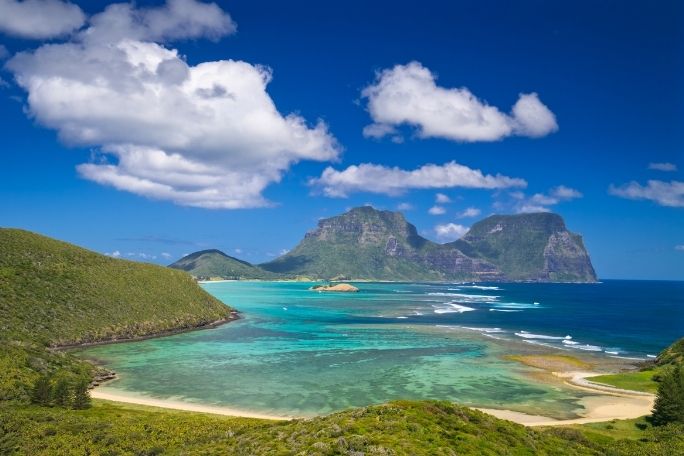Lesson summary
Students are introduced to Lord Howe Island. They begin by thinking about what an island is before locating Lord Howe Island on a map. They then work in groups to create their own map of Lord Howe Island that includes information about climate conditions, plants and animals, human infrastructure and natural geographical features. Students share their map with peers before creating a Padlet to record this information as a personal reference resource (the Padlet will be referred to and built upon during subsequent lessons in this unit). Finally, if students are completing all the lessons in this unit they will be asked to begin designing their own island.
Learning intentions:
Students will...
- understand what an island is
- recognise some of the key features of Lord Howe Island.
Success criteria:
Students can...
- locate Lord Howe Island on a map
- undertake and communicate research around the geography and natural features of Lord Howe Island
- create their own map of Lord Howe Island incorporating natural geographical features and using BOLTSS conventions
- think creatively about their own island designs and design an island that includes natural geographical features (optional).
Lesson guides and printables
Curriculum links
Select your curriculum from the options below.
Lesson details
Curriculum mapping
Australian curriculum content descriptions:
Year 5 HASS:
- Locate and collect relevant information and data from primary sources and secondary sources (ACHASSI095)
- Organise and represent data in a range of formats including tables, graphs and large- and small-scale maps, using discipline-appropriate conventions (ACHASSI096)
- Present ideas, findings, viewpoints and conclusions in a range of texts and modes that incorporate source materials, digital and non-digital representations and discipline-specific terms and conventions (ACHASSI105)
Year 6 HASS:
- Locate and collect relevant information and data from primary sources and secondary sources (ACHASSI123)
- Organise and represent data in a range of formats including tables, graphs and large- and small-scale maps, using discipline-appropriate conventions (ACHASSI124)
- Present ideas, findings, viewpoints and conclusions in a range of texts and modes that incorporate source materials, digital and non-digital representations and discipline-specific terms and conventions (ACHASSI133)
Syllabus outcomes: GE3-4
General capabilities: Critical and Creative Thinking
Cross-curriculum priority: Sustainability OI.2
Relevant parts of Year 5 HASS achievement standards: Students locate and collect data and information from a range of sources to answer inquiry questions. They sort, record and represent data in different formats, including large-scale and small-scale maps, using basic conventions. They present their ideas, findings and conclusions in a range of communication forms using discipline-specific terms and appropriate conventions.
Relevant parts of Year 6 HASS achievement standards: Students locate and collect useful data and information from primary and secondary sources. They organise and represent data in a range of formats, including large- and small-scale maps, using appropriate conventions. They present ideas, findings, viewpoints and conclusions in a range of communication forms that incorporate source materials, mapping, graphing, communication conventions and discipline-specific terms.
This lesson is part of the wider unit of work Lord Howe Island – Years 5 & 6
Time required: 60+ mins
Level of teacher scaffolding: Medium – lead students in class discussions and activities, guide students through map-making activity
Resources required
- Access to a device for each student so they can create a Padlet
- BOLTSS Conventions
- Device capable of presenting a video to the class
- Geographical Features – Optional
- Lord Howe Island – Overview Factsheet
- Map of Australia featuring Lord Howe Island – you can use Google Maps; however, the satellite imagery of Lord Howe Island on Google Maps is of relatively poor quality and may be a distraction for students.
- Student Worksheets – one copy per student
Skills
This lesson is designed to build students’ competencies in the following skills:
- Communication
- Creativity
- Critical thinking
- Collaboration
Additional info
These lessons were made possible with thanks to Joshua Yeldham.
If you would like to access additional information about Joshua Yeldham and the photographs of his wonderful exhibition 'Providence'. Please visit the Arthouse Gallery website: Joshua Yeldham - Providence (arthousegallery.com.au/exhibitions/joshua_yeldham/providence) and the artist's website: Joshua Yeldham (www.joshuayeldham.com.au) for exhibitions and his wonderful book: Surrender (joshuayeldham.com.au/the-books). Providence and Surrender were completed during and after his Artist Residency on Lord Howe Island and during his stay at the Capella Lodge (capellalodge.com.au) on Lord Howe Island.


Welcome back!
Don't have an account yet?
Log in with:
Create your free Cool.org account.
Many of our resources are free, with an option to upgrade to Cool+ for premium content.
Already have an account?
Sign up with:
By signing up you accept Cool.org's Terms and Conditions(Opens in new tab) and Privacy Policy(Opens in new tab).